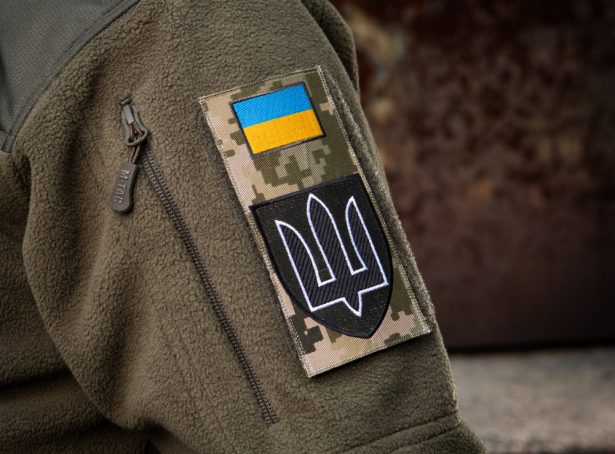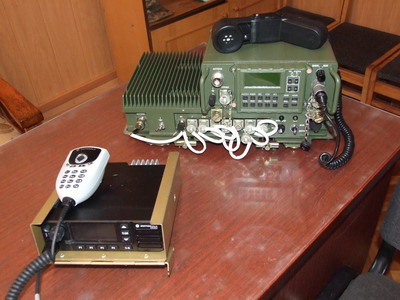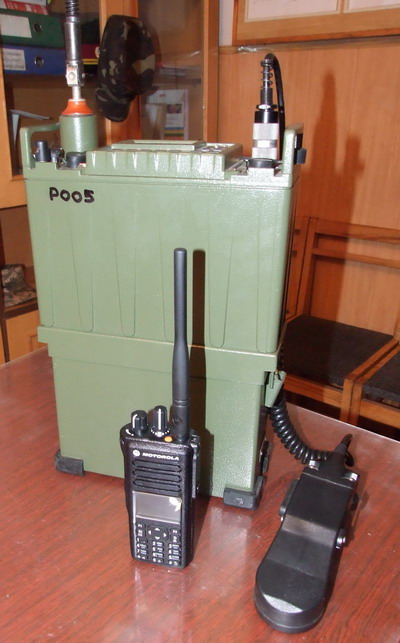Interview: “To protect Ukraine, high-quality communications are more needed in the trenches than in headquarters”
10.06.15
With these words, the chief of communications of the Armed Forces of Ukraine, Major General Vladimir Vasilyevich Rapko, began our conversation. Among the topics discussed: the situation with equipping the armed forces with communications equipment a year ago, the tasks facing the communications department at the present time, issues of introducing Ukrainian developments and much more.
Tell us about the situation that developed with the provision of communications equipment to the Armed Forces of Ukraine at the beginning of 2014.
By the beginning of 2014, 30% of fixed communication systems were digitalized, and only one or two percent of mobile ones. All other equipment were systems that had been in service since the times of the USSR. That is, the communication was analogue with the exception of some tropospheric stations and a few complex hardware developments in 2007. On the eve of the war, no money was allocated for the purchase of communications equipment. But, for example, in 2013, about $250 thousand was spent on a settlement and information center in Sevastopol.
What priority tasks was the communications department forced to solve at the beginning of the conflict in Donbass?
There was a certain bias: in the army, communications equipment was mainly developed at the headquarters level and mainly in stationary systems. The needs for supplying tactical-level communication systems were practically ignored, and endless development of documentation and prototyping was carried out without real funding. It was believed that during hostilities we would somehow make do with what we had.
As the conflict in Donbass has shown, digitalization of the fixed-line communication system does little to help conduct combat operations on the battlefield, but rather serves for the convenience of command. But combat missions, as we know, are carried out not by headquarters, but by those in the trenches. Therefore, the most important problem during the outbreak of the conflict was the provision of communications equipment to the tactical command level.

Vladimir Rapko: “If departments really want to interact, then there are no technical or organizational problems for this”
In cooperation with other law enforcement agencies, including volunteer IT specialists, a search for optimal means of communication was carried out, and then they were tested. The chosen solution corresponds to the threats facing and, importantly, fits into the allocated budget. It includes several subsystems, including encryption. Unfortunately, the funds allocated to us in 2014 and 2015 do not allow us to fully satisfy the army’s needs for digital communications. Today, a modern scalable communication system has been built in the ATO zone, which allows for operational control of troops, and we have almost switched to a digital method of processing and transmitting information. Previously operated analog hardware platforms and all outdated Soviet communications equipment are gradually being replaced with modern digital ones. In the most important places, replacement took place back in 2014.
To what extent are the communication, radio intelligence, and suppression systems used by pro-Russian units in the current conflict superior to similar Ukrainian ones?
The communication systems of the LPR and DPR are, as a rule, analog and at first were generally built on ordinary mobile phones. The advanced units of the Russian Armed Forces located on the territory of the LPR/DPR use digital stations such as “Aqueduct” and “Peanut”. This equipment has never been in service in Ukraine. We are now studying radio stations taken from Russian armored vehicles destroyed in the ATO. In terms of their technical characteristics, they are an order of magnitude weaker than the systems that we put into service in the Armed Forces of Ukraine. We have been allocated a certain amount of budget funds to equip us with modern means of communication, and our foreign partners and volunteers are helping.
What challenges does your department face now?
Firstly, as the number of troops increases, we are faced with the task of equipping them with appropriate communications equipment. The second task is to significantly increase the classified communications system (to each individual unit performing a combat mission). The third task is to increase control stability by creating the required number of backup nodes and communication lines.
What are the greatest difficulties faced by the Armed Forces of Ukraine in the interaction of various units?
I will answer briefly: if departments really want to interact, then there are no technical or organizational problems for this.
There is a lot of talk about the use of ordinary mobile phones by our military in the ATO zone, which makes it possible not only to listen to them, but to easily detect the unit itself. What is the Ukrainian Armed Forces command doing to minimize losses?
It is prohibited to use mobile communications without the permission of the commander (chief) in the ATO zone. The closer to the front line, the more strictly the ban on the use of mobile terminals is observed. In fact, it is technically possible for all servicemen in the ATO to call relatives at home free of charge from special communication points on the ground.
Why, at the beginning of the ATO, were Motorola radios purchased in large quantities for the armed forces, border troops, and the National Guard, and not Ukrainian-made systems?
Many investigations by the competent authorities have been carried out on this case. Unfortunately, the bureaucratic lobby protecting the interests of certain Ukrainian producers has not calmed down to this day. Inquiries and investigations are ongoing. The products offered to us by domestic developers are long outdated and more expensive than Western systems for similar purposes. A simple example: for the funds allocated for the purchase of these systems, we could equip only five battalions with Ukrainian radio stations. And only in 2015. But thanks to the above-mentioned advantages, already in 2014 we were able to purchase 18 times more Motorola radios. Moreover, they are modern, combat-tested ready-made systems.
The developments of Ukrainian origin that existed at that time were outdated and very expensive. For example, a 5-W radio station without cryptographic protection of Ukrainian origin cost 133.6 thousand UAH, and a 5-W “Motorola” – 7.5 thousand UAH with cryptographic protection and a delivery time in any quantities of up to two months.
A comparative analysis of trunking radio stations in terms of price and quality showed the feasibility of choosing Motorola radio stations, which made it possible to equip 90 battalions of the Armed Forces of Ukraine in May 2014. I repeat: if we were waiting for supplies from Ukrainian developers, then the same money would be enough for five battalions and not earlier than 2015.
Why not stations made by Kenwood or Hytera?
A market study was carried out, tactical and technical characteristics were compared, and a number of field and laboratory tests were carried out. There is a conclusion from the relevant experts. And in addition, during the tender, Motorola stations turned out to be cheaper than their American (Kenwood) and Chinese (Hytera) counterparts.

Radio stations of Western and Ukrainian production. With comparable technical characteristics and the same protection (IP67), Western analogues are much cheaper and more convenient
How expedient is it to use foreign models of communication systems? Or is it still more profitable to develop domestic samples?
The ideal option is to have everything of your own. Unfortunately, in previous years the army was not particularly pampered, and those Ukrainian developments that began in the late 90s became hopelessly outdated already at the stage of the release of industrial designs. Today we actually don’t have anything modern that has been put into service. In Ukraine, radio stations, radio relay, and tropospheric systems are being developed, but the element base is imported, and the components themselves are often copied from foreign analogues. Therefore, the line between a national manufacturer and a foreign one is very blurred.
Foreign radio systems are already ready-made and proven solutions that you simply buy along with a warranty, service, and specialized software. With those developed in Ukraine, everything is more complicated: 60% is the cost of foreign components, 10% is a special protected chassis or housing, 30% is production costs, including software development. And in fact, we have on our hands a rather “raw” product that requires fine-tuning – an outdated analogue of an imported radio station at a price commensurate with or even higher than that of a Western model.
Imagine a modern smartphone and a mobile phone from 2007 (assuming both are IP67 rated). Which one would you prefer?
The only solution to the issue today is technology transfer with the opening of appropriate modern production facilities on the territory of Ukraine. It is very important that the station software is national, since it must provide reliable security, encryption and other system-critical characteristics. There are several enterprises in Ukraine with the ability to replicate advanced technologies, and we are working with them. They have great potential for development, but currently available developments, unfortunately, lag significantly behind modern requirements. We have no right to wait – we need to arm the army now. Or better yet, yesterday.
What is the most difficult part of your job?
Of course, there is an external enemy who uses electronic radio suppression, physical destruction of communications and people themselves. But, unfortunately, the current legislation and lobbying of the interests of various businesses cause no less difficulties. That is, where there is actually no war.
A lot of time is spent on a large number of investigations beyond what is reasonable, writing explanations to requests from regulatory authorities and people’s deputies. The latter often simply defend someone’s business interests. And we, in turn, are forced to defend our decisions on purchasing this or that equipment to them. This all takes a lot of time. Over the last month alone, we have had about ten requests from such “Autobots”, each of which excluded some of the officers of the main communications department from work, effectively paralyzing its work. There are hostilities going on, people perform their official duties almost around the clock, they have to go on business trips, to tests, to the ATO, sometimes to see their family or just relax.
I would like to express special words of gratitude to the volunteers for their inexhaustible material and intellectual assistance.
Help
Rapko Vladimir Vasilievich. Born in 1965 in the city of Sambir, Lviv region. He graduated from the Poltava Command Higher School of Communications in 1986, then served in the Turkestan Military District. After the collapse of the USSR, he continued to serve in the Carpathian Military District. He served as chief of communications for the 60th separate special forces battalion in Yugoslavia in 1994. He was the commander of a centrally subordinate communications brigade. He held the positions of deputy, first deputy chief of the Armed Forces of Ukraine. Since January 2015 – Head of the Ukrainian Armed Forces Signal Corps.
Read also about the artificial discrediting of Ukrainian generals
Editorial director
Don't miss interesting news
Subscribe to our channels and read announcements of high-tech news, tes
Oppo A6 Pro smartphone review: ambitious

Creating new mid-range smartphones is no easy task. Manufacturers have to balance performance, camera capabilities, displays, and the overall cost impact of each component. How the new Oppo A6 Pro balances these factors is discussed in our review.
Top news of 2025 on hi-tech.ua

Our editorial team traditionally sums up the results every year. We recently showcased the editors’ top devices. Now it’s time to share the top news stories from hi-tech.ua in 2025.
You can no longer activate Windows online via phone Microsoft operating system Windows
Telephone activation no longer functions, despite the fact that it formally continues to exist in Microsoft’s reference materials.
Samsung Galaxy S26 will cost the same as the Galaxy S25. Company will fix the price business rumors Samsung smartphone
Samsung faced rising costs and currency fluctuations, but chose not to pass on the extra costs to customers.







